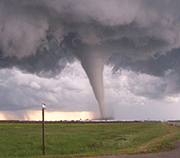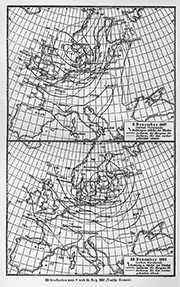E-Archive
Off the Beaten Track
in Vol. 14 - November Issue - Year 2013
Talk about the Weather


A weather map of Europe in 1887
"So the whirlwind originates in the failure of an incipient hurricane to escape from its cloud (¡K) and it consists of the spiral which descends to the earth and drags with it the cloud which it cannot shake off. It moves things by its wind in the direction in which it is blowing in a straight line, and whirls round by its circular motion and forcibly snatches up whatever it meets."
So the fourth-century B.C. Greek philosopher Aristotle described the properties of tornadoes in his treatise entitled Meteorologica, which arrived to us in a twelfth-century Latin translation. Aristotle¡¦s work illustrates his theories on various earth sciences, including geology, geography, the four elements, earthquakes and weather phenomena. He also addressed topics such as astrology and chemistry. Although his four-volume work contains several significant errors, Aristotle also made some surprisingly accurate observations concerning the weather, so much that his text was considered the ultimate authority on this subject for almost two thousand years.
One of Aristotle¡¦s disciples, the philosopher Theophrastus, described his observations in a book entitled the Book of Signs, in which he catalogued his methods for predicting eighty types of rain, fifty types of thunderstorms, and twenty-four types of good weather.
At about the same time that Aristotle was expounding his theories, weather prediction methods based on observed patterns of events were being developed in China and India, although it must be said that three centuries earlier, the ancient Babylonians had attempted to predict changes in the weather based on cloud types and astrology.
In 904 A.D., the Arab scholar Ibn Wahshiyya published his Nabatean Agriculture, in which he presented his ideas on weather forecasting based on planetary alignments, lunar phases, and the movement of winds.
However, as long as weather forecasting was confined to the realm of philosophical speculation, it was evident that no real progress could be achieved. A significant qualitative leap was finally made in the Renaissance thanks to the invention of the first rudimentary instruments. Nicholas Cusa and Leonardo da Vinci designed hygrometers, Galileo Galilei invented an early type of thermometer, and Evangelista Torricelli invented the barometer. In 1667, Robert Hooke invented the anemometer. It was finally possible to make meteorological observations based on accurate measurements.
The very first international weather observation network, financed by the ruling Medici family, was established in Florence in 1657. Instruments were sent to various stations around Europe and readings were relayed to Florence on a regular basis, allowing researchers to compare collected data. Although this procedure contributed enormously to a better understanding of observed meteorological phenomena, it still did not allow any type of weather forecasting, since the data had to travel by horse across Europe, arriving much too late to be of any practical use.
While instruments and measurement techniques were being perfected and refined in the course of the eighteenth and nineteenth centuries, more and more observation posts were springing up around the world. Researchers had a better understanding of the relationship between values for moisture, temperature and pressure and atmospheric events. Scientists from many countries around the world and active in various fields of study contributed important discoveries that also benefited the nascent science of meteorology.
Modern weather forecasting began with the invention of the electric telegraph in 1835. It was now possible to receive weather reports from a wide area simultaneously and to make accurate forecasts based on the knowledge of weather conditions further upwind. The Times published the first daily weather forecast on 1st August 1861.
Significant progress was made in 1930 when the Russian scientist Pavel Molchanov developed a model of radiosonde still in use today. A radiosonde is a system by which helium or hydrogen-filled balloons carry weather instruments and a radio transmitter high into the atmosphere. The radio transmitter relays various atmospheric parameters in real time to a receiver on the ground, where the data can be processed immediately and used for constructing weather maps or inserted into computer programs for weather forecasting. At present hundreds of radiosondes are launched every day from weather stations all over the world.
The next big leap took place in the first half of the twentieth century, when the idea of using mathematical equations for predicting the weather was first proposed by the Norwegian scientist Vilhelm Bjerknes in 1904 and developed by the British mathematician Lewis Richardson in the 1920¡¦s. These equations, which are now the basis for modern weather forecasting, consider the present state of the fluid (the atmosphere) and apply the laws of fluid dynamics and thermodynamics to predict the state of the fluid at a given time in the future. Nowadays powerful computers routinely make the high number of calculations required by these equations in a matter of seconds, but Richardson had estimated that it would have been necessary to have 64,000 persons divided into groups, each computing separate sections of the equations, just to elaborate a six-hour weather forecast!
By Giovanni Gregorat, Contributing Editor MFN
Author: Giovanni Gregorat



























